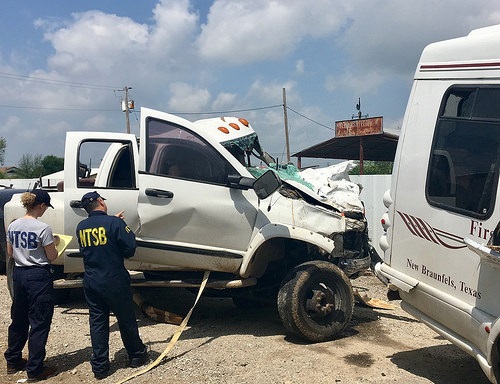Analysis of 2017 fatality data by the National Transportation Safety Board indicates that highway crashes accounted for 95 percent of the 38,958 people who died in transportation-related accidents in 2017.
[Above photo by NTSB.]
NTSB’s analysis, released on Nov. 1, noted that 712 fewer people died in transportation accidents in 2017 compared to 2016, with aviation, marine and highway deaths decreasing as rail- and pipeline-related fatalities experienced an increase. The agency noted that 58 more people died in railroad sector accidents in 2017 versus 2016.
Yet even though 673 fewer people died in highway crashes in 2017 compared to 2016, NTSB Chairman Robert Sumwalt said in a statement that highway crashes are “completely preventable.”

NTSB’s breakdown of national transportation fatality statistics for 2017 also revealed:
- Aviation deaths decreased from 412 in 2016 to 350 in 2017. While general aviation showed the largest decrease with 56 fewer deaths, general aviation again accounted for 94 percent of all aviation fatalities.
- Recreational boating accidents killed 43 fewer people in 2017 than in 2016, but 27 mariners died in commercial fishing in 2017, compared to 17 in 2016. Overall, there were 39 fewer deaths in marine transportation compared to the 733 fatalities in 2016.
- Highway fatalities decreased from 37,806 in 2016 to 37,133 in 2017, and crashes involving passenger cars, light trucks and vans, pedestrians, motorcycles, “pedalcycles,” and buses resulted in fewer deaths. However, fatalities associated with crashes involving medium- and heavy-duty trucks increased to 841 in 2017 compared to 725 in 2016.
- Four more people died in pipeline accidents in 2017 compared to the 16 who died in 2016.
The agency added that preliminary aviation accident statistics showed a slight decrease in the number of U.S. civil aviation accidents, with 1,316 in 2017 compared to 1,335 in 2016.
There were 10 fewer fatal general aviation accidents in 2017 than in 2016, and the fatal accident rate remained below one fatal accident per 100,000 flight hours for a second consecutive year, NTSB pointed out.
 Nation
Nation


